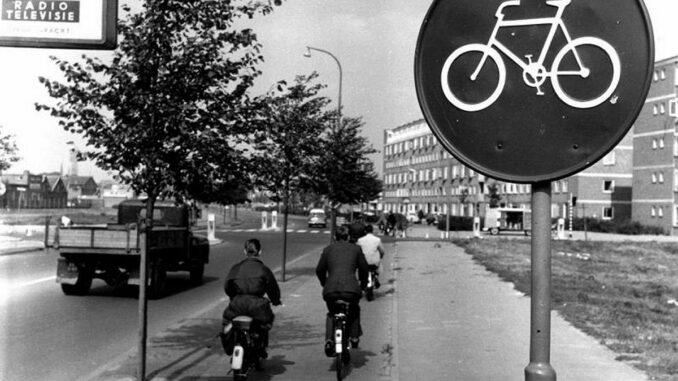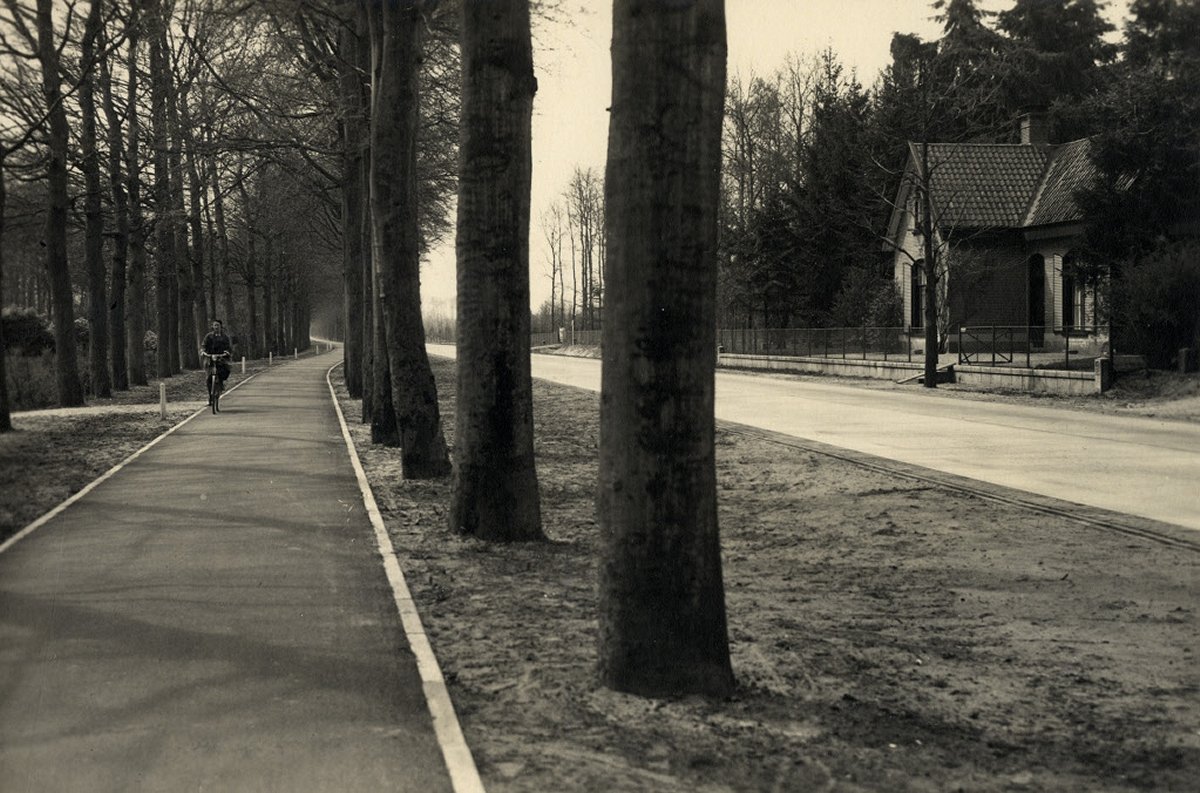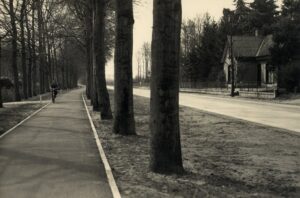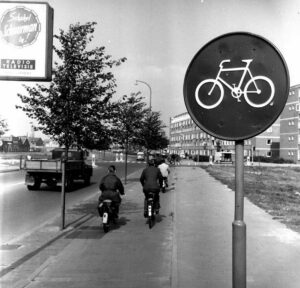
Blog by Henk-Jan Dekker (TUe) for the Cycling Community.
Historian Henk-Jan graduated in September 2021 from Eindhoven University of Technology with a dissertation entitled Cycling Pathways: The Politics and Governance of Dutch Cycling Infrastructure, 1920-2020. Based on extensive archival research he charted the past of Dutch cycling policy. The Open Access version of the book can be read on the site of Amsterdam University Press.
Congestion on the cycling path?
My dissertation attempted to answer the question: where does cycling belong, both on the road and in terms of policymaking and governance? By going through multiple archives I tried to reconstruct Dutch cycling policy over the past century. In this blog I want to briefly introduce two key moments from the history of the cycling path, based on the second and fifth chapters of my book: respectively, the introduction of the bicycle tax in the 1920s and the rise of the moped in the 1950s.
The origins of separated cycling paths alongside main roads lies in the 1920s. Before that decade, cycling paths alongside roads were occasionally constructed, although more often for recreation and leisure in nature. These paths were typically not connected to roads and constructed by private cycling path organizations with little help from the government. In 1926 the Road Fund was introduced to serve commuter traffic and the growing economic importance of motorized traffic. Intended to provide a new and improved road network for the car (seen as the future), this new policy also entailed the introduction of a bicycle tax. Given the still very modest amount of car drivers, a tax on vehicles or gas did not bring in sufficient funds to undertake this ambitious road program. The many cyclists could contribute substantially and were made to pay an annual bicycle tax. The fact that it was hard to justify making cyclists pay for roads they would not be allowed to use was widely debated and understood. Importantly, therefore, engineers and politicians agreed that the Road Fund also had to be used to construct cycling paths. As the influential politician A.G.B.M. van Rijckevorssel succinctly put it in 1936: “It is not right to fob off cyclists with a partial solution when this category of road users contributes so much tax money.” This was a fairly representative sentiment.

The rising class of drivers and truck-operating industrialists also preferred to remove cyclists from the road for an unobstructed drive. Engineers were willing to accommodate this and regularly referred to what they regarded as the undisciplined and chaotic behavior of cyclists. This attitude was common enough among engineers; in this respect the Netherlands was no different than elsewhere. At the same time, and partly due to the bicycle tax’s existence, engineers also argued cycling path quality had to be high. In an article in the engineer magazine Roads (‘Wegen’) in 1929, engineer Taeke Huitema asserted that cyclists often suffered from “dissoluteness, desire to annoy, thoughtlessness or drowsiness” making them ride in the middle of the road. At the same time he remarked: “Among many roads there is a narrow cycling path on one side, not separated from the road paving. Cars often divert over these cycling paths or drive on them, damaging them and making them hard and dangerous to cycle on.” If engineers wanted to ‘seduce’ cyclists into making use of cycling paths, they believed these paths had to be wide, well-paved and comfortable to use. Photographic evidence from the 1920s and 1930s shows that many (provincial) engineers did indeed start to construct high-quality separate cycling paths alongside national and provincial roads. The bicycle tax unwittingly contributed to this: despite putting (the car drivers) burden on (working-class) cyclists, it did also create a long-lasting tradition of building separate infrastructure in the Netherlands.
A second example of unintended positive consequences of mobility policy for cycling is visible in the rise of the moped. From the late 1940s this vehicle started to conquer the road of many European countries. Initially no more than a bicycle with a small engine mounted on the front wheel, technical improvements quickly made it faster and bigger. Soon, a debate arose about the proper place of the moped as well. Since the network of separate cycling paths had become substantial by 1950, there was a choice to be made about where the moped had to go. In other countries this choice did not really exist. In the Netherlands, ultimately, arguing that the speed difference between cars and mopeds was larger than that between cars and bicycles, the moped was referred to the cycling path.
This decision once again prioritized drivers over cyclists, who now had to share the (not all that wide) cycling paths with overtaking moped riders. Newspapers from the 1950s are full of angry letters from cyclists and moped riders who literally and figuratively clashed on the cycling path. One moped rider wrote to the journal Moped Champion: “I assure you that I am not a speed maniac and rushing is madness, but to restrict the moped in the way proposed is very unfair. We have to keep moving and if the experienced moped rider, who doesn’t run any more than the normal risk on the road, is stuffed away on the cycling track between honorable fathers and mothers with kids in the front and backseats, it is going to be a mess, I am telling you.”
While these strong feelings existed, my research also shows that engineers and politicians saw the rise of the moped as an important reason to keep constructing (and widening) cycling paths. Many European countries completely lost track of and interest in cycling in the 1950s and 1960s. In the Netherlands, partly due to the long-term effects of the bicycle tax and traffic separation, and partly due to the rise of the moped, cycling paths remained part and parcel of engineering practice. As a result by the late 1960s cycling levels in the Netherlands had not dropped as far as elsewhere and were still sizeable. This in turn was a fruitful breeding ground for cycling activism which, from the 1970s onwards, started to reconquer urban space from the car.
The question of where cyclists belong has new urgency today in the Netherlands. Cycling is popular and cycling paths are busier than ever. While mopeds are now increasingly moved back from the cycling path onto the road in cities, the rise of e-bikes has perpetuated the problem. Speed difference is an issue when cycling paths become really busy. Does traffic separation still have the future in the Netherlands? It is a model that has been crucially important in ensuring the long-term persistence of cycling in the Netherlands since it made cycling compatible with high levels of driving. Elsewhere, the rise of the car made cycling on the road increasingly dangerous and challenging. Today, after 50 years of cycling advocacy and the increasing awareness of the urgency of environmental issues, there is perhaps finally enough political support for further limiting car access to cities. If that is the case, maximum speeds for cars might drop further. Indeed, a proposal to limit this speed to 30 km/h in Dutch cities was recently approved. With speeds like that, e-bikes and mopeds can probably safely use the road and leave existing cycling paths to slower cyclists. Traffic separation will remain necessary where car speeds are too high. However, the era of traffic separation, where all two-wheeled vehicle have to fend for space on the same narrow cycling path seems to be over.
Photo credits and captions:

Example of a separate cycle path along the provincial road Soestdijk-Bilthoven (Netherlands) ca. 1924-34. The cycle path is on the site of the old road, to the right of the trees a new road has been constructed [Photographer unknown, Collection Het Utrechts Archief, no. 220773]

A moped rider overtakes a cyclist on a cycle path along Briljantlaan in Utrecht (Netherlands), 1962 [Photographer L.H. Hofland, collection The Utrecht Archives, no. 125585]

You must be logged in to post a comment.